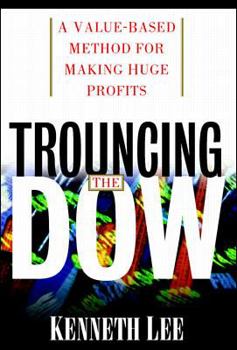Trouncing the Dow: A Value-Based Method for Making Huge Profits in the Stock Market
Presenting a method of selecting Dow Jones Industrial stocks which will produce an average annual return of 28 per cent over 24 years, Kenneth Lee here focuses on a little-used financial ratio called... This description may be from another edition of this product.
Format:Hardcover
Language:English
ISBN:0070383014
ISBN13:9780070383012
Release Date:August 1998
Publisher:McGraw-Hill Companies
Length:284 Pages
Weight:1.28 lbs.
Dimensions:1.0" x 6.2" x 9.3"
Customer Reviews
5 ratings
Simple, workable system!
Published by Thriftbooks.com User , 19 years ago
As some other reviews of this book state, there are NO perfect mathematical formulae for selecting investments. No formula can consistently anticipate all of the myriad changes that can affect a particular issue in the highly fluid, dynamic universe of investments. All valuation formulae are simplistic constructs which are used in the place of an elusive, magical crystal ball to derive either the absolute or relative worth of financial instruments. And all such constructs must be based upon assumptions (which are subject to all sorts of errors)- all of them! Perhaps the most widely-used financial formulae today are based on some variant of discounted cash flow (DCF). But DCF requires selection of an appropriate discount rate, a forecast of future cash flows, and some kind of wild-eyed guess as to the investment's terminal value. Calculations which substitute earnings for cash flow are hopelessly flawed from the outset! Any calculation which uses a forecast is probably "in over its head" before any processing is done. Since we cannot find the perfect formula which will yield calculations of 100% certainty, perhaps we should base our investment philosophy on skilled analyses of financial statements. However, financial statements are also built upon (possibly flawed or outdated) assumptions and conventions, and are hopelessly backward-looking while markets are always forward-looking. Financial information is too stale and is often inaccurate (vide ENRON or WorldCom, etc.). Maybe following news releases would be better. However, because markets are discounting mechanisms, most of the financially important events are already incorporated into the market price before the news is released. Try an experiment: record the breaking news stories, both positive and negative, on any financial news network and see how well the companies and their stock prices perform 30, 90, 180, and 365 days after the news release. On many of the positive stories, you will find that the stock price will sell no, or only marginally, higher on the day of the release, and thereafter. You will often find the converse for negative news releases. Buying on positive- or selling on negative- releases is not likely the way to make consistent profits in the financial markets. Then there is technical analysis, which is often not very technical at all. Last week, a major bank group fired the entire staff from its 45 year-old technical analysis department because the bank's management could not find added value to its overall operations from this department. However, Andrew Lo, et. al., from the Massachusetts Institute of Technology, performed a study on technical analysis over a 30 year period and found that certain indicators provided an incremental benefit to investment returns over the period studied. There may be some utility to be mined from this area. All the above said, Lee's book offers a simple method for selecting undervalued stocks from the universe of the Dow Jones 30 Ind
Great book
Published by Thriftbooks.com User , 24 years ago
Reading TTD, after reading other books on 'Value Investing' I actually found a strategy that I could use. I have been a student of finance over 30 years and have read other books, and this book gave me 'the tools' to evaluate a companies a companies potential. I can't say that this book will teach you everything, but it does a very good job of teaching you the basics. Though 'value investing' is not in favor for the current times, I do believe it is the most sensible approach to evaluate a company, and over the long term will prove to be a better approach then chasing the 'whats hot on wall street' method.If you are a conservative invester, read this book. If you are an aggressive investor, looking for returns of 30% or more(every year), good luck.
Every Serious Investor Should Read This Book
Published by Thriftbooks.com User , 25 years ago
Despite the gimmicky title that kept me from buying it when it first came out last year, I now consider Trouncing the Dow to be one of the best investment books ever written for the serious long-term investor. I'd put it right up there with classics like The Intelligent Investor, Stocks for the Long Run, A Random Walk Down Wall Street, One up on Wall Street, The Warren Buffett Way, Reminisces of a Stock Operator, Supermoney, and Against the Gods.
Great Book. Now A Very Good Website
Published by Thriftbooks.com User , 25 years ago
I love the strategy this book unveils. Now, it appears Ken has a website where the method is applied to not only Dow Stocks, but also the S & P 100 and Nasdaq 25. If you're in investing for value and the long-term, this site may be worth the price...
Graham, Keynes, and Buffet rolled into one.
Published by Thriftbooks.com User , 25 years ago
Kenneth Lee presents his version of value/contrarian investing in this excellent book, which is filled with insight from some of the greatest investors of all time. His valuation model is easy to apply and takes the emotion out of investing. He preaches classic ideas such as margin of safety and buying fallen stocks. This book is 'the book' for anyone who wants to maximize return while minimizing risk. He also recommends additional books on investment that should be included in any serious investors' library.





